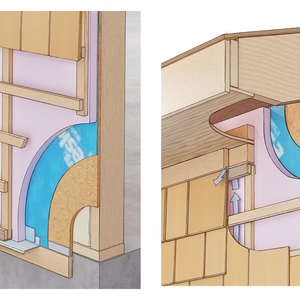CCSI ConstructionCrimeSceneInvestigator
I went to a clients house today that had mold growing on interior walls of an addition built ten years ago. The addition is 18×10. It is built ten feet out from the house eighteen feet wide. It has a shed roof with no overhang. It appeared that the mold on the sheetrock ran in vertical stripes every 16 inches. There also was a band of mold along the top 10 inches of the wall. It is located in hot and humid coastal South Carolina.
We tore off the vinyl siding to find properly applied 30# felt over 1/2″ plywood. The plywood was attached with sheetrock screws to 6″ metal studs about 83″ tall spaced 16″ OC. Six inches of fiberglass insulation was properly installed. On top of the metal studs was a 10″ tall by 6″ wide I-beam! with a 2×6 on top and bottom. There was no mold or evidence of water upon opening up the walls. The right side of the addition (where the mold is)is in the shade most of the time and the left side is usually in the sun due to positioning on the lot and various trees (where no mold is).
I have never run across condensation from metal studs causing mold on the interior wall surfaces. I propose to tear out all the metal and rebuild with wood. I can’t guarantee it won’t happen again if I leave the metal in place.
Any other fixes I could consider???
Constructing in metric…
every inch of the way.



















Replies
what if you sheeted the outside with a 1-1.5 foam,if i was tearing the sheetrock off,might look at a foam sheet there also.
or if they could spare the room,stud another wall inside the existing with a thermal break,loose 4" but it would be better than rebuilding.
i konow a guy 10 years ago built a house with steel,the utility bills were about 2.5 times a house with wood.sure was cool looking when they was building. larry
if a man speaks in the forest,and there's not a woman to hear him,is he still wrong?
The foam on the exterior in his climate would do the job if thick enough and if sealed with tape at joints
Welcome to the Taunton University of Knowledge FHB Campus at Breaktime. where ... Excellence is its own reward!
holy,
Sounds like soot is collecting on the rock just over the steel. Ask your clients if they burn candles or have another source of soot. Don't think it's mold.
KK
Good suggestion. I saw something like that once, myself.
Another possibility is slightly higher levels of condensation on the drywall at the metal studs. Metal conducts heat better than wood and the wall temperature at the studs can be lower than between them. If there's poor air circulation in the room mold can form where the moisture level is higher because the temperature is cooler.
If the room is closed off so air can't get to the return, open a door and see what happens.
Tearing out the steel and replacing with wood is your best bet, IMO. From your description, wherever there is steel, there is the black stuff. I agree that the thermal conductivity of the steel is the most likely culprit, and that would indicate that the problem occurs mostly in winter when the drywall at the steel studs/I-beam becomes a condensing surface.
The foam is a good idea, too, but the wood is the most important step.
Bill
Strong feeling it is not mold as it is to uniform.
Steel studs have a tendency in the cold to attract soot or dirt and will cause dark shadows on the drywall.
See your local metal stud supplier for proper explanation.
It is not soot. It is definitely mold. Installing insulation on the outside is not possible due to there are no eaves. The inside room where there is mold is in a large 10x10 closet. The mold was mostly, but not entirely, behind clothes and a dresser. There is an HVAC duct in the center of the room that seems to put out a steady flow of air.
I thought of insulation on the inside, building the wall out, but won't that lead to condensation inside the wall and a possible mold case inside the wall?
This addition was built with whatever was laying around in the guy's garage that built this mess. The effort it took to put up an I-Beam around the top of the structure and to use metal studs far outweighed just stickbuilding the walls with 2x4's or 2x6's. (I am having a Holmes on Homes moment.) I could have framed this addition in two hours tops. Ahhhh....The lengths novices will go to save money!!! :+)
Constructing in metric...
every inch of the way.
In your climate foam on interior is more likely to trap the condensation inside the wall for worse results. At least it is on the surface now.No way to retrim the roof line?with absolute zero overhang, that is a problem that should be addressed anyways
Welcome to the Taunton University of Knowledge FHB Campus at Breaktime. where ... Excellence is its own reward!
Yeah, we talked about extending the roof line, but that is another whole can of worms. We could add to the rafter tails and put a soffit and fascia on. I would still worry about the steel condensing inside the wall.Constructing in metric...
every inch of the way.
to add 1-1/2" of foam outside all you neeed is another two by subfascia, new fascia and a gutter/eave edge combo
Welcome to the Taunton University of Knowledge FHB Campus at Breaktime. where ... Excellence is its own reward!
"There is an HVAC duct in the center of the room that seems to put out a steady flow of air."Is there a return in the room or is the door well under cut to give a return path for the air with the door closed? If not their won't be much air with the door closed.Also if this is a closet then if the walls are packed with you will have a large areas where you the air flow is limited.Is there any mold on the out side of the DW?IIRC the FG insulation used with metal studs is friction fit and unfaced. Is there any kind of moisture retarder in the wall anyplace?Is there anything on the DW other than paint?
.
.
A-holes. Hey every group has to have one. And I have been elected to be the one. I should make that my tagline.
The mold was mostly, but not entirely, behind clothes and a dresser
Might be an air circulation issue, especially with the humidity levels SC is known for.
Might just be that more air circulation in the closet will help.
My thought would be to strip the inside wall board and strap the studs then install a mold-resistant board. Might be worth finding one of the hang-in-the-closet humidity control devices out there.Occupational hazard of my occupation not being around (sorry Bubba)
You have to prevent thermal bridging through the steel (studs and beam) either on the inside or the outside. If steel bridges both warm and cold, you will get condensation on the cool side, which will turn to mould if there is a food source. (drywall paper, wallpaper, wood etc)
Your only solution is to insulate over the studs to prevent bridging or replace the framing with wood members. Likely better to insulate
I'm in a different climate than you, so it would be better to get local advise on where best to insulate.